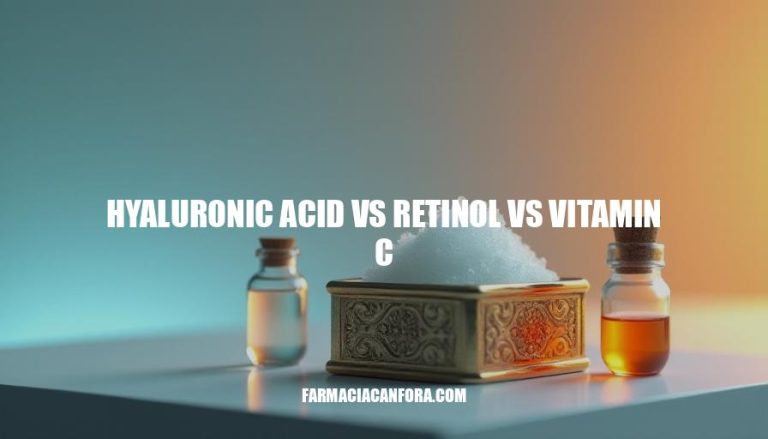


Hyaluronic acid, retinol, and vitamin C are three powerful ingredients that are changing the way we take care of our skin. They’re like superheroes that target specific skin concerns and help us achieve healthier, more radiant skin.
Hyaluronic acid is amazing at holding onto water, which makes it super good at keeping our skin hydrated and plump. It also helps reduce fine lines and wrinkles, giving our skin a smoother look.
Retinol is like a magic eraser for our skin.
It helps get rid of wrinkles, uneven skin tone, and acne by stimulating collagen production and speeding up cell turnover.
Vitamin C is a shield that protects our skin from environmental stressors like UV rays and pollution. It also brightens our complexion and gives us a radiant glow.
Each ingredient has its own special powers, but they work together in amazing ways too. By understanding how they can help with different skin concerns, we can create personalized skincare routines that give us the best results.
Hyaluronic acid, retinol, and vitamin C are three powerhouse ingredients in skincare, each with distinct roles and benefits. Here’s a detailed breakdown of their functional differences, how they interact with the skin, their effectiveness for various concerns, and their compatibility when combined.
Hyaluronic acid (HA) is a naturally occurring glycosaminoglycan found in the skin, joints, and connective tissues. Its primary function in skincare is hydration.
HA is a humectant, meaning it attracts and retains water, holding up to 1,000 times its weight in moisture. This makes it ideal for:
Hydration: It replenishes and locks in moisture, leaving the skin plump and smooth.
Elasticity: Well-hydrated skin appears more elastic and youthful.
Fine Lines and Wrinkles: By hydrating the skin, HA temporarily reduces the appearance of fine lines and wrinkles.
Soothing: It calms irritation and supports the skin barrier.
HA is suitable for all skin types, including sensitive and acne-prone skin. It works well with most other ingredients and is often used as a base layer in skincare routines to enhance the absorption of subsequent products.
Retinol, a derivative of vitamin A, is a gold-standard ingredient for anti-aging and skin renewal.
It works by increasing cell turnover and stimulating collagen production. Its benefits include:
Anti-Aging: Reduces fine lines, wrinkles, and sagging by boosting collagen.
Acne Treatment: Unclogs pores and prevents breakouts.
Pigmentation: Fades dark spots, sun damage, and hyperpigmentation.
Texture Improvement: Smooths rough skin and refines pores.
Retinol is highly effective but can cause irritation, redness, and peeling, especially for beginners. It is best introduced gradually and used at night, as it can make the skin more sensitive to sunlight.
Retinol should not be combined with other potent actives like benzoyl peroxide or high concentrations of acids, as this can exacerbate irritation.
Vitamin C is a potent antioxidant that protects the skin from free radical damage caused by UV rays and pollution. It also plays a key role in brightening and evening out the skin tone. Its benefits include:
Brightening: Reduces dullness and enhances radiance.
Hyperpigmentation: Inhibits melanin production, lightening dark spots and discoloration.
Collagen Synthesis: Supports collagen production for firmer skin.
Protection: Neutralizes free radicals, preventing premature aging.
Vitamin C is most effective in its stable forms, such as L-ascorbic acid, and works best in the morning under sunscreen.
It can be sensitive to light and air, so proper storage is crucial. Combining vitamin C with niacinamide or ferulic acid can enhance its stability and effectiveness.
Hyaluronic Acid with Retinol or Vitamin C: HA pairs well with both retinol and vitamin C. It helps counteract the dryness and irritation that retinol may cause and enhances the absorption of vitamin C.
Retinol and Vitamin C: These two can be tricky to combine due to their differing pH requirements.
Using them at different times of the day—vitamin C in the morning and retinol at night—is a common approach to avoid conflicts.
Layering: When layering, apply products from thinnest to thickest consistency. HA is typically applied first, followed by vitamin C or retinol, depending on the routine.
Each of these ingredients serves a unique purpose, and their effectiveness depends on individual skin concerns and how they are incorporated into a routine. Proper usage and combination can maximize their benefits while minimizing potential side effects.
Hyaluronic acid, retinol, and vitamin C are three powerful ingredients that cater to different skin concerns. Hyaluronic acid is ideal for hydration, elasticity, and fine lines, making it suitable for all skin types. Retinol, a derivative of vitamin A, targets anti-aging, acne, and pigmentation, but can cause irritation and requires gradual introduction.
When combining these ingredients, follow this guideline:
Remember to store vitamin C properly and avoid combining it with niacinamide or ferulic acid without proper guidance. By understanding the unique benefits of each ingredient and tailoring your skincare routine accordingly, you can maximize their effectiveness while minimizing potential side effects.